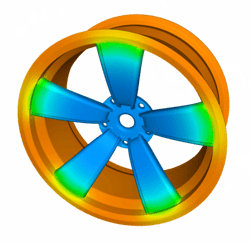 Aluminum is a durable light material that is easy to cast or form. It is only through heat treatment, however, that it obtains the necessary mechanical properties for industrial purposes.
Aluminum is a durable light material that is easy to cast or form. It is only through heat treatment, however, that it obtains the necessary mechanical properties for industrial purposes.
The SIMHEAT® finite element simulation software simulates quenching and artificial ageing of aluminum thanks to the introduction of quench factor analysis (QFA) and the Shercliff-Ashby model. These models predict the local physical and mechanical properties in aluminum components in response to precipitation hardening on well-known Al-alloys of the 2xxx, 6xxx and 7xxx series.
Aluminum heat treatment cycles
Heat treatment of aluminum is mainly based on precipitation mechanisms. There are three classic stages as shown in the diagram below.
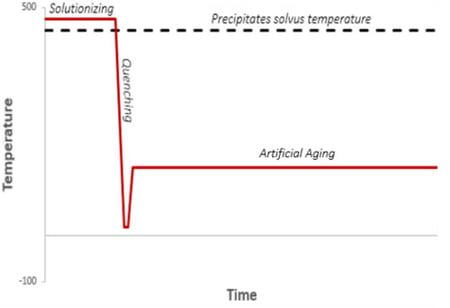
solutionizing of aluminum alloys
The solutionizing phase is intended to eliminate precipitates in the matrix of the material. This complex phase is not yet simulated. Instead, the hypothesis is made that the material properties are reinitialized to an ideal state.
Quenching of Aluminum alloys
The quenching phase accelerates cooling to avoid the formation of a coarse non-hardening precipitate, and to keep the solid solution at lower temperatures.
In SIMHEAT®, quenching is represented through two models:
- A phenomenological model based on the calculation of a quenching factor, QFA, which measures the effectiveness of quenching.
- A thermomechanical model that gives access to residual stresses and predicts potential cracks due to quenching.
The quenching factor quantifies the ability of an aluminum alloy to harden during quenching. If the quenching is sufficiently energetic, this factor is worth 1 and the alloy has the maximum capacity to harden. In the opposite case, if the quenching is slow, this factor is worth 0 and the capacity of the alloy to harden is null.

Where σ is the hardness:
QFA=1 => σ - σmax : fast quenching
&
QFA=1 => σ - σmin : low quenching
Where:
σmin = pure aluminum hardness (1xxx H2 or H4): ~30 HV
σmax = max hardness obtained at the Jominy curve: 175 HV
The QFA factor depends on the amount of untransformed solute during quenching. In the anisothermal cooling description, the QFA factor is given by:

The parameters K2, K3, K4, K5 and n are defined using a Jominy test.
Where:
𝐾2 = constant related to the reciprocal of nucleation site numbers
𝐾3 = energy required to form a nucleus (J.mol-1)
𝐾4 = homogenization temperature
𝐾5 = diffusion activation energy
n = 1 (hardness varies linearly with the amount of solute available)
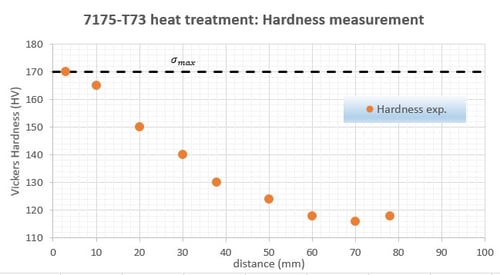 Jominy test for hardness measurement - Measurement of Vickers hardness as a function of distance
Jominy test for hardness measurement - Measurement of Vickers hardness as a function of distance
Artificial ageing of aluminum alloys
After quenching, an artificial ageing stage is performed at temperatures normally between 100 and 200 °C. The goal is to control the rate of precipitates that harden the metal. Artificial ageing is characterized and simulated using a Shercliff-Ashby method which establishes that the final mechanical resistance is the sum of the pure aluminum strength (σmin), of hardening due to the formation of a solid solution (Δσss), and hardening due to second-phase precipitates (Δσppt) as shown below:
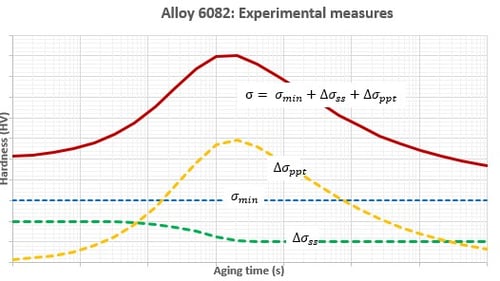
Coupling QFA & Shercliff-Ashby models
By coupling both the QFA & Shercliff-Ashby models, it is possible to fully simulate a consecutive quenching and ageing treatment of an aluminum alloy.

Competitive features of SIMHEAT® for aluminum heat treatment
- Artificial ageing based on a Shercliff-Ashby model for heat-treatable aluminum alloys;
- Distortion model applicable to aluminum alloys
- Material sensor tracking to plot characteristics over the treatment
- After artificial ageing, the contributions of precipitate and solid solutions to hardening are identified
- Complete results: temperature, quenching efficiency, HV/HRC hardness, residual stress, yield stress
CAse studies of aluminum heat treatment simulation
residual stresses and dimensional changes of an extruded 2024 L-shape
SIMHEAT® software is also able to predict residual stress distribution and the amplitude of the distortion profile caused by the quenching and artificial ageing steps. The Von Mises effective stress values presented in Figure 1 are found to be within the range of acceptable tolerances, like that obtained in traditional quenching, between 0 MPa and 140 MPa.
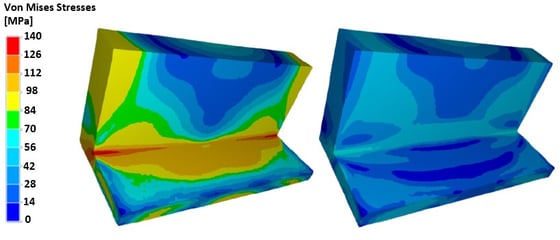
Figure 1: Von Mises stress (MPa) for 2024 L-Shape (left) after quenching and (right) after quenching and artificial ageing.
Stresses tend to drastically increase during quenching due to large thermal gradients and are partially relaxed to half their maximum values after ageing at 190°C. We can note that we do not consider the effect of precipitation on residual stresses, which would probably help to relax the microstructure after ageing.
In Figure 2(a), the effective strain obtained after quenching is shown and local plastic deformation due to quenching is observed. Using SIMHEAT®, it is possible to highlight this plastic deformation and amplify the result of the distortion by applying a multiplicative factor on the scale of displacement. It thus becomes very easy to understand where the distortions are the greatest and to make comparisons with a non-deformed shape.
Figure 2(b) shows this numerical functionality: it is easier to understand how the L-shaped workpiece bends due to the spray quenching used in this study.
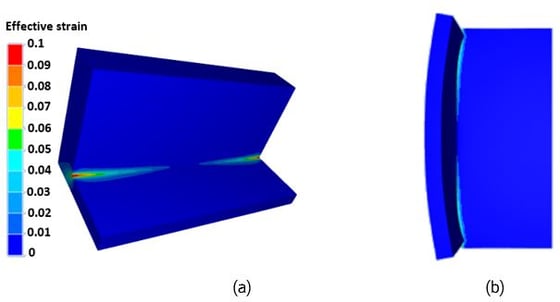 Figure 2: (a) SIMHEAT® quenching simulation for the 2024 L-Shape (a) Plot of the equivalent strain after quenching and (b) Distortion due to quenching magnified x20. The L-shape is shown from a top-view, the distortion of the thin section is particularly visible.
Figure 2: (a) SIMHEAT® quenching simulation for the 2024 L-Shape (a) Plot of the equivalent strain after quenching and (b) Distortion due to quenching magnified x20. The L-shape is shown from a top-view, the distortion of the thin section is particularly visible.
simulation of the quenching and artificial ageing of an aluminum 6061 wheel rim
This animation presents the evolution of the quenching factor after quenching and artificial ageing on a wheel rim. Numerical simulation ensures your components’ mechanical performances and a mastery of the product’s dimensions by minimizing distortions.
Evolution of the quenching factor after quenching and artificial ageing of an aluminum 6061 wheel rim




